Picasso: Odes to Nature
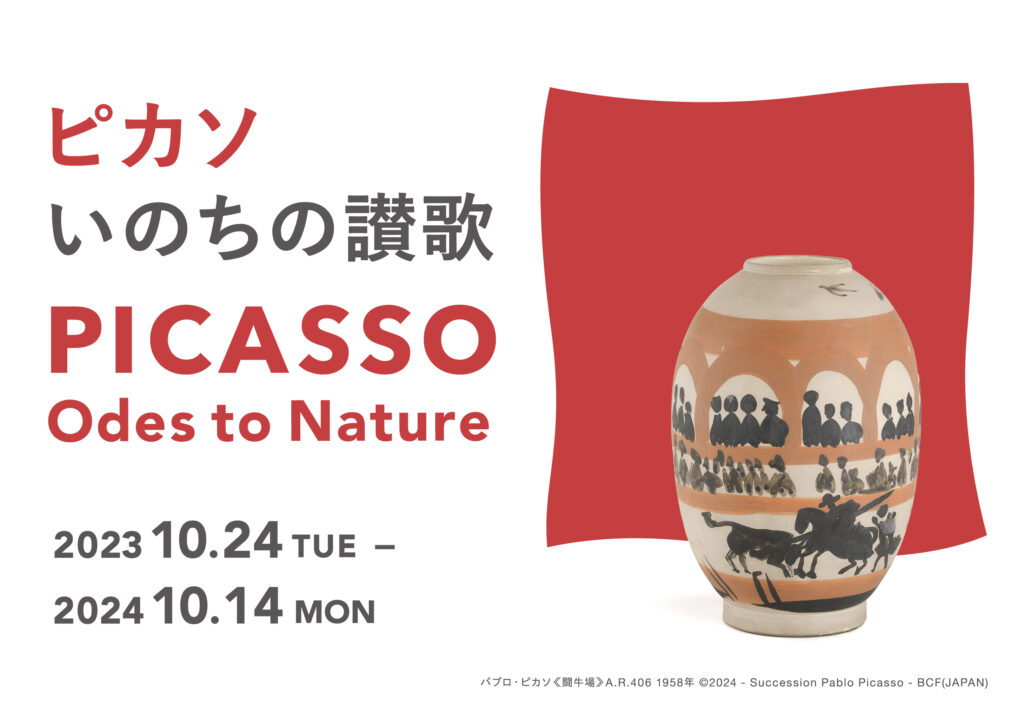
Exhibition title: Picasso: Odes to Nature
Dates: Tuesday, October 24, 2023–Monday, October 14, 2024
Supervised by Takao Okamura (Art historian)
Supervised by Tsukasa Machida (Curator, Kuboso Memorial Museum of Art, Izumi)
Picasso: Odes to Nature Venue: YOKU MOKU MUSEUM
Organized by YOKU MOKU MUSEUM
Closed on Mondays (but open when Monday is a public holiday) and for year-end/New Year holidays.
Opening hours: 10:00–17:00 (Last admission 30 minutes before closing)
Supported by Minato City Board of Education
Special Cooperation from YOKU MOKU CO., LTD.
Outline of the Exhibition
Picasso: Odes to Nature is the fourth in a series of exhibitions introducing the YOKU MOKU Collection from different perspectives. Supervised by two experts, this exhibition delves into Picasso’s deep affection and empathy for living things, which serve as the source of “vitality” brimming in his ceramic works, with a variety of motifs as clues. Takao Okamura is former professor at Tokyo Zokei University and has written many books on Picasso and Spanish art. Tsukasa Machida is curator at Kuboso Memorial Museum of Art, Izumi and an enthusiastic young researcher on Pablo Picasso.
It was after World War II that Picasso began producing ceramic works in full. He moved his base to the south of France, which shares the Mediterranean Sea with his native city, Málaga, and there, his work underwent further development.
One of the characteristics of these ceramic works lies in the point that they represent various creatures and forms of life surrounding Picasso himself. During the artist’s lifetime, there were two world wars, and many lives were lost due to diverse unjust causes. To Picasso, who suffered from growing apprehensions about death, the termination of World War II would have been a great joy and signified the victory of life.
This exhibition is presented in five chapters, namely The Bullfight and Picasso; La Paloma—thoughts on the dove—; Owls—Keen Eyes—, Palm-Sized Organisms—Sea Creatures, Insects, and Birds—; and Joie de Vivre, Pan, and Jacqueline.
We hope you will give thought to how Picasso observed the glittering signs of life and expressed even the sparkles beyond life on clay.
Summaries of the Chapters
Ⅰ.The Bullfight and Picasso
A picture of a bullring in Málaga drawn by Picasso when he was nine years old remains. It shows a bullfighter being tossed up on the horns of a bull. Soon afterward, he painted Picador in oil.
Later on, Picasso said he wanted to become not a matador, who plays the leading role in the bullfight, but a “picador.” He adored the picador, who, on horseback, plays the key role of inciting the bull with a lance to enhance its combative spirit and, at the same time, wear out its strength. The bullfight became one of Picasso’s much depicted subjects.
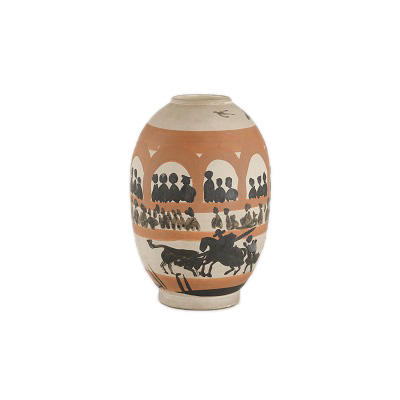
Pablo Picasso, Arena, A.R.406, 1958, thrown white earthenware, decorated with slips, interior with transparent glaze, h. 32 × w. 23 × d. 23 cm.
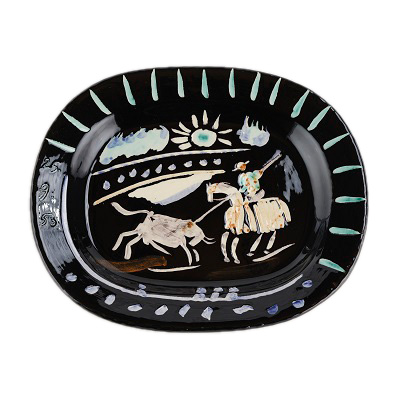
Pablo Picasso, Corrida Sun, A.R.199, September 25, 1953, press-molded, white earthenware, decorated with colored slip, incised, transparent glaze, h. 4.2 × w. 37.5 × d. 30.5 cm.
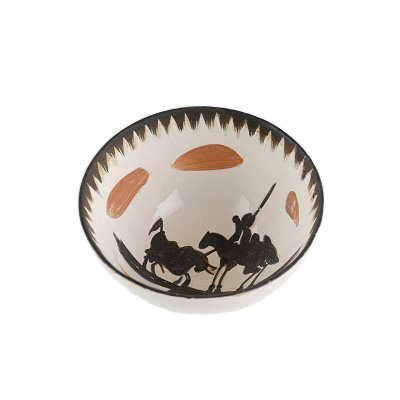
Pablo Picasso, Picador, A.R.289, 1955, thrown white earthenware, decorated with slips, wax resist, glaze, h. 6.6 × w. 12.5 × d. 12.5 cm.
Ⅱ.La Paloma —Thoughts on the Dove—
Picasso built a dovecote on the balcony of La Californie, his villa in the outskirts of Cannes, and raised pigeons. As his father was known as a painter of doves, he was familiar with them. In 1901, he painted Child with a Dove, and the same subject again after Nazi Germany invaded Paris. When the World Congress of the Peace Partisans was held in 1949, a lithograph of a dove by Picasso was chosen for the poster. Two months later, Picasso and Françoise Gilot had a daughter, and they expressed their affection by naming her Paloma (Spanish for dove).
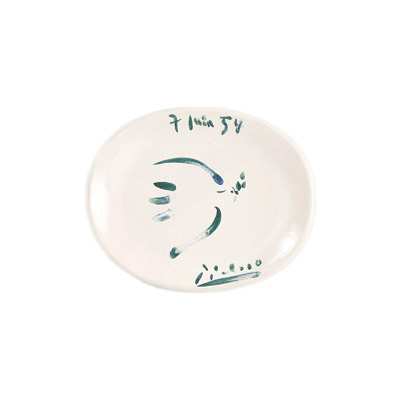
Pablo Picasso, Dove, June 7, 1954, white earthenware, with slips, transparent glaze, h. 2 × w. 17.8 × d. 22 cm, unique piece
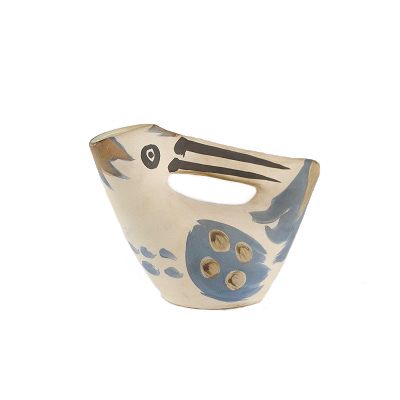
Pablo Picasso, Handled Pitcher as a Bird, A.R.186, April 4, 1953, thrown white earthenware, decorated with slips, incised, glazed interior, h. 20 × w. 29 × d. 11 cm.
Ⅲ. Owls —Keen Eyes—
Picasso happened to take care of an injured owl he came across at Château Grimaldi in 1946, and from then on, owls were to appear frequently in his works. Its puffy form and expressions, which can occasionally appear comical, proved a huge source of inspiration for Picasso to create his ceramic works. The owl’s beady, impressive eyes implying the artist’s trademarked intense gaze and its unique expression somehow reminding us of human beings narrate the affection Picasso felt for this bird.
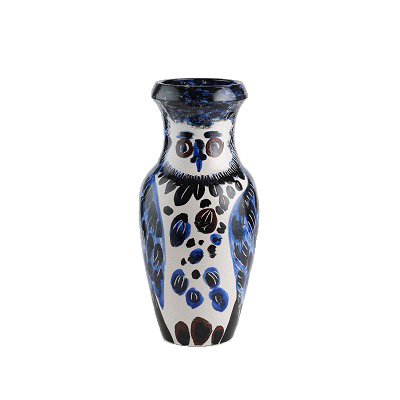
Pablo Picasso, Owl, A.R.158, 1952, thrown white earthenware, decorated with oxides, incised, white glaze, h. 54 × w. 24 × d. 24 cm.
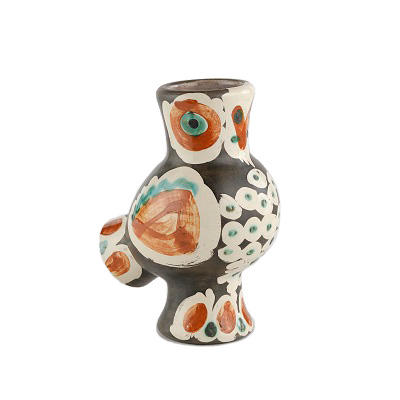
Pablo Picasso, Wood-Owl, A.R.542, 1968, white earthenware, thrown elements, gouged, decorated with colored slip, transparent glaze, gray patina, h. 30 × w. 24 × d. 16 cm.
Ⅳ. Palm-Sized Organisms —Sea Creatures, Insects, and Birds—
Life in Vallauris in the south of France was overflowing with colors different from Paris, where Picasso had been based until then. Fish and sea urchins were part of the daily life in Vallauris and would have been served frequently as local cuisine. Portrayed in that location, they gave off a fresh vividness. The liveliness of unnamed birds, grasshoppers, and tiny insects painted on vessels small enough to be held in one’s hand show how Picasso loved and cared for the little living creatures and the everyday life together with them.
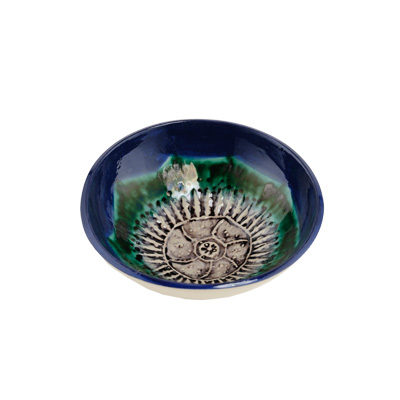
Pablo Picasso, Sea Urchin, A.R.268, March 31, 1955, empreinte originale, white earthenware, decorated with slips, transparent glaze, h. 6.7 × w. 17.5 × d. 17.5 cm.
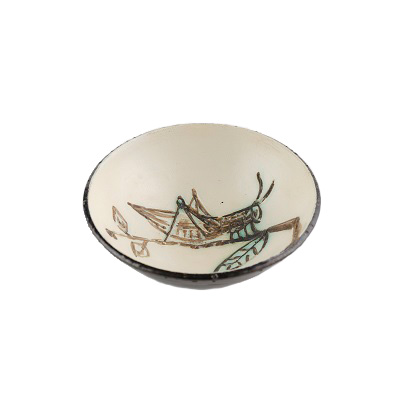
Pablo Picasso, Grasshopper on a Branch, A.R.258, 1955, empreinte originale, white earthenware, decorated with oxide, wax resist, incised, transparent glaze, h. 6.3 × w. 18 × d. 18 cm.
Ⅴ.Joie de Vivre, Pan, and Jacqueline
Picasso painted The Joy of Life, Antipolis in 1946, when Françoise Gilot was pregnant. She is flanked by Pan and a centaur each playing a pipe to congratulate her. It shows how delighted the sixty-five-year-old Picasso must have been. After a while, he began to concentrate on producing ceramics.Then, Jacqueline arrived at the studio. As she spoke Spanish and had met Picasso at the bullring in Perpignan in summer, they were able to chat at ease in their mother tongue. However, the month after Jacqueline arrived at the studio, Françoise Gilot left with her children.
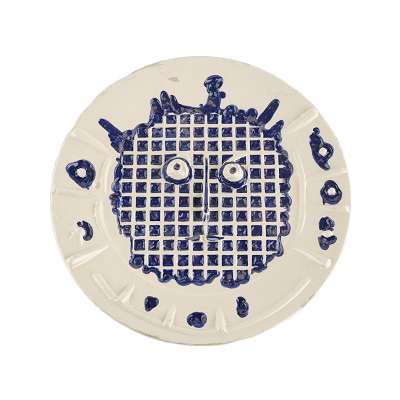
Pablo Picasso, Face with Grid, A.R.352, 1956, empreinte originale, white earthenware, decorated with slip, partial transparent glaze, h. 4.6 × w. 43 × d. 42.5 cm.
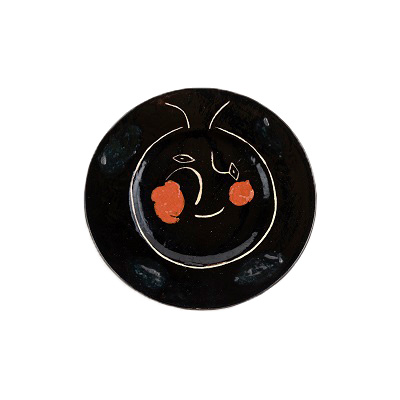
Pablo Picasso, Black Face (“Black Face” service plate L), A.R.47, 1948, press-molded white earthenware, decorated with slips, incised, transparent glaze, h. 2.5 × diam. 24 cm.
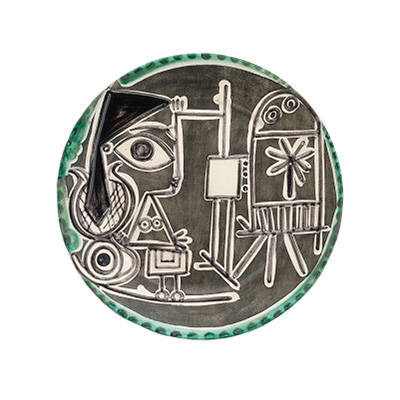
Pablo Picasso, Jacqueline at the Easel, A.R.333, 1956, empreinte originale, white earthenware, decorated with slips, partial transparent glaze, gray patina, h. 4 × diam. 42 cm.
Supervisors
Takao OKAMURA
Completed PhD program without a PhD degree, Graduate School of Letters, Arts and Sciences, Waseda University. Having filled various posts such as professor at Tokyo Zokei University and first director of Tokyo Zokei University Museum, Okamura is currently active as a freelance art historian and art critic. Member of AICA (International Association of Art Critics) Japan. Specializes in Spanish art history and twentieth-century European art. He has written many books including Pikaso no togei (Picasso’s ceramics) (PIE International, 2014). Translated Dalí (Robert Radford, Iwanami Shoten, 2002) etc. Supervised numerous exhibitions including Collection of the Hakone Open-Air Museum: Picasso (The Hakone Open-Air Museum, 2003). Has been organizing Okamura Takao Kikakuten, exhibitions to support young artists, from 1996.
Tsukasa MACHIDA
Completed PhD program without a PhD degree, Graduate School of Letters, Arts and Sciences, Waseda University. After serving as assistant (curator) at Aizu Museum, Waseda University, Machida has been curator at Kuboso Memorial Museum of Art, Izumi from 2013. Specializes in Pablo Picasso, particularly his work after World War II and how it was received. Curated Picasso and Japanese Art—Charm of Various Lines— (Kuboso Memorial Museum of Art, Izumi, 2017). Dissertations include “Picasso, Japan, Barcelona” (in Japanese), in Pikaso to jinrui no bijutsu (Sangensha, 2020) and “Kataru Pikaso, katarareru Pikaso,” (in Japanese), in Picasso escritor, exhib. cat. (Instituto Cervantes de Tokio, 2020). Winner of the Kajima Foundation for the Arts Award (2014).
ⓒ2023-Succession Pablo Picasso-BCF(JAPAN)
